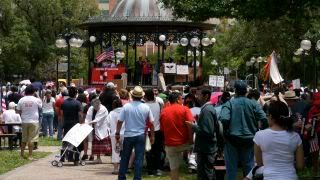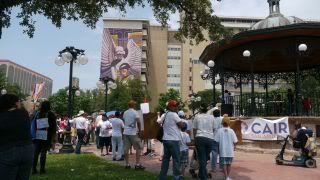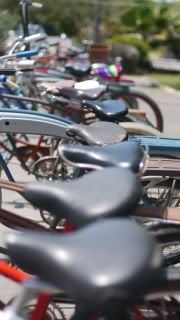Saturday. May Day.
Last night I headed over to URBAN-15 to watch a free screening provided by AIT-SCM (American Indians in Texas at the Spanish Colonial Missions). I realized it had been quite some time since I last visited their offices over on Guadalupe. The lovely office manager, Diane Castro, was carrying around her adorable eight month-old baby. A new addition to her life I wasn’t aware of.
The evening began with a reception in the garden. By the seven o’clock screening time, the crowd was up to about a hundred people. And by the time the lights went up at the end, I was able to see just how many people had been arriving late. The place was packed to near capacity.
The film was “A Thousand Roads,” a forty minute film produced by the Smithsonian Institute. The director, Chris Eyre, is perhaps best known for his earlier features, “Smoke Signals,” and “Skins.” “A Thousand Roads” is a sort of vérité-esque narrative of four different contemporary Native Americans dealing with issues of traditional identity within the modern world. The cinematography is absolutely stunning. We also viewed a documentary about the making of this film.
AIT Executive Director, Ramon Juan Vasquez, and Director of Programs, Issac Cardenas, led a discussion and Q&A session afterwards. I keep forgetting how common it is for Texans NOT to know the history of the indigenous people in their own state, and more specifically, the region around San Antonio. I guess I make an unreasonable assumption that everyone in Texas has at least read Newcomb’s excellent overview, “The Indians of Texas.” (And, really, every Texan should have a copy on his or her shelves–hell, I think I have TWO…get it together, folks!). There was one guy in the audience–an African American from Chicago–who asked a few basic questions about Indians in Texas and San Antonio. Before Ramon or Isaac could reply, Henry Cisneros (who was in attendance with his wife, Councilwoman Mary Alice Cisneros) stood up and gave a nice short but comprehensive summation of the history of the Native Americans in Texas and how important they were settling this area in the pre-contact period, and how, later, they served to build this city.
The evening was closed out with AIT Director of Programs, Isaac A. Cardenas, setting up a large drum and inviting some of the young people in attendance to accompany him with their drumming on a couple of native songs.
During the screening I was sitting with my friends Deborah Keller-Rihn and Ramon Vasquez y Sanchez (the father of the AIT director). (As a parenthetical aside, we three comprise the ad-hoc art and cultural collective, Proyecto Locos.) Afterwards the three of us took a later dinner at Titos. Ramon said how he thought the best part of the night was the discussion period at the end. “People need to knows these things,” he said. Yes they do.
@@@@@
May Day.
On May First, I woke up with the best of intentions. I was going to get out there and seize the day. But I switched on the computer and looked to see what new goodies had been posted on Hulu.com. That pissed away a couple of hours.
Eventually I looked at the time. It was past noon. And if I didn’t head out to Milam Park for the International Workers Day March, I’d feel like an idiot. This opportunity was not only tantamount to doffing my cap (red) as a quasi-Communist (and I’m fine with that), but it was also the place to be to show my public disdain for that unconstitutional and patently bigoted Arizona Senate Bill 1070.
So, I made a FaceBook posting, stating I was heading out to Milam Park. Now I was committed. So, I hopped on my bike and rode downtown.
I was hoping for a larger turnout. I don’t think there were more than 800 people in the park. Too bad. People missed some nice speeches and statements.
Mayor Julian Castro didn’t mince words. He was forceful, specific, and impassioned about how Arizona’s 1070 is ill-conceived and antithetical to the American spirit. The San Antonio Chief of Police, William McManus, made a short speech. Not only did he state that were Texas to adopt a similar bill, all the elements of trust built up between the police and the public would be destroyed; moreover, he echoed the words from the police chiefs of Tucson and Phoenix in that it is not the job of municipal peace keepers to enforce federal laws.
Later, as I was concentrating on a speech by an activist which was delivered entirely in Spanish, this guy walks up beside me.
“So, what is this? Some kind of protest?”
I turn around. It’s an anglo guy in his forties. I assumed him to be a tourist. And even though his dress was somewhat blue collar–baseball cap, jeans, and a denim shirt, tucked in, I could read the signs well enough to know he was a Republican.
“Something like that,” I said.
“Wish I spoke Spanish,” he said, looking toward the stage where the activist was speaking. “I guess it’s something about that Arizona law.”
“Well, this is the annual May Day workers’ march. But because of this new law in Arizona, this event has also embraced the issue.”
“So,” he said, folding his arms and looking over at me. “Where do you stand on the issue?”
“I think it’s a terrible law.”
He replied that he was all for it.
Now I should point out that he didn’t gravitate to me because I was the only other white person in the park. Maybe ten percent of the crowd was anglo.
I was tempted to explain that this was basically the annual communist march here in San Antonio, and I was here to show my support to all my brave comrades and fellow travelers, be they reds, black bloc anarchists, pinkos, or card-carrying Wobblies…but I didn’t want to feed him too much confusing information.
“The fact is,” he said. “We need these guys, these illegals. But we need to find how to make them legal. It’s a failure of the federal government.”
I was intrigued. Maybe I miss-read this guy.
“I got a business three hundred miles to the north,” he said. “And at any given moment I have thirty of these illegals working for me. They give me social security numbers. But at the end of each year, when I send in my paperwork to the IRS, they say these social security numbers are bogus. And if I use these workers for another year, I’ll have to pay their employment taxes.”
As I was trying to envision what sort of sweatshop he was running in Dallas or Fort Worth, he said something about how he thought it was wrong for illegal immigrants to protest the immigration issue. “See what I’m saying? It’s just not right.”
I tried to explain that when you fight for human rights, when you advocate for global tolerance and compassion, it doesn’t matter who you are, where you are, or what your legal status might be.
He was nodding as though he were listening to what I was saying.
“Yep. We need to get some cops in here and separate the legals from the otherwise. It’s not fair that those illegals are complaining and not paying taxes.”
I was pretty certain that no more than 5 percent of the people in the park (less than the white folk) were currently undocumented aliens, but what could I say? The guy had his mind made up. He saw a surging crowd of brown people. He assumed that they were all, like his under-paid labor back home, filthy foreigners.
I tried not to let his words drag me down. I wandered off and had a blast talking to the folks in the crowd and reading their signs.
I took some photos of the event.
@@@@@
I also made a quick strafe by the Slow and Low San Antonio Bike Show at Blue Star. I took a few photos of cool bicycles.
Next I took the 20 mile bike ride from my house to Mission Espada and back. It’d been months since I undertook such a serious ride. I made pretty good time out and back, but, damn, I’m woefully out of shape.




